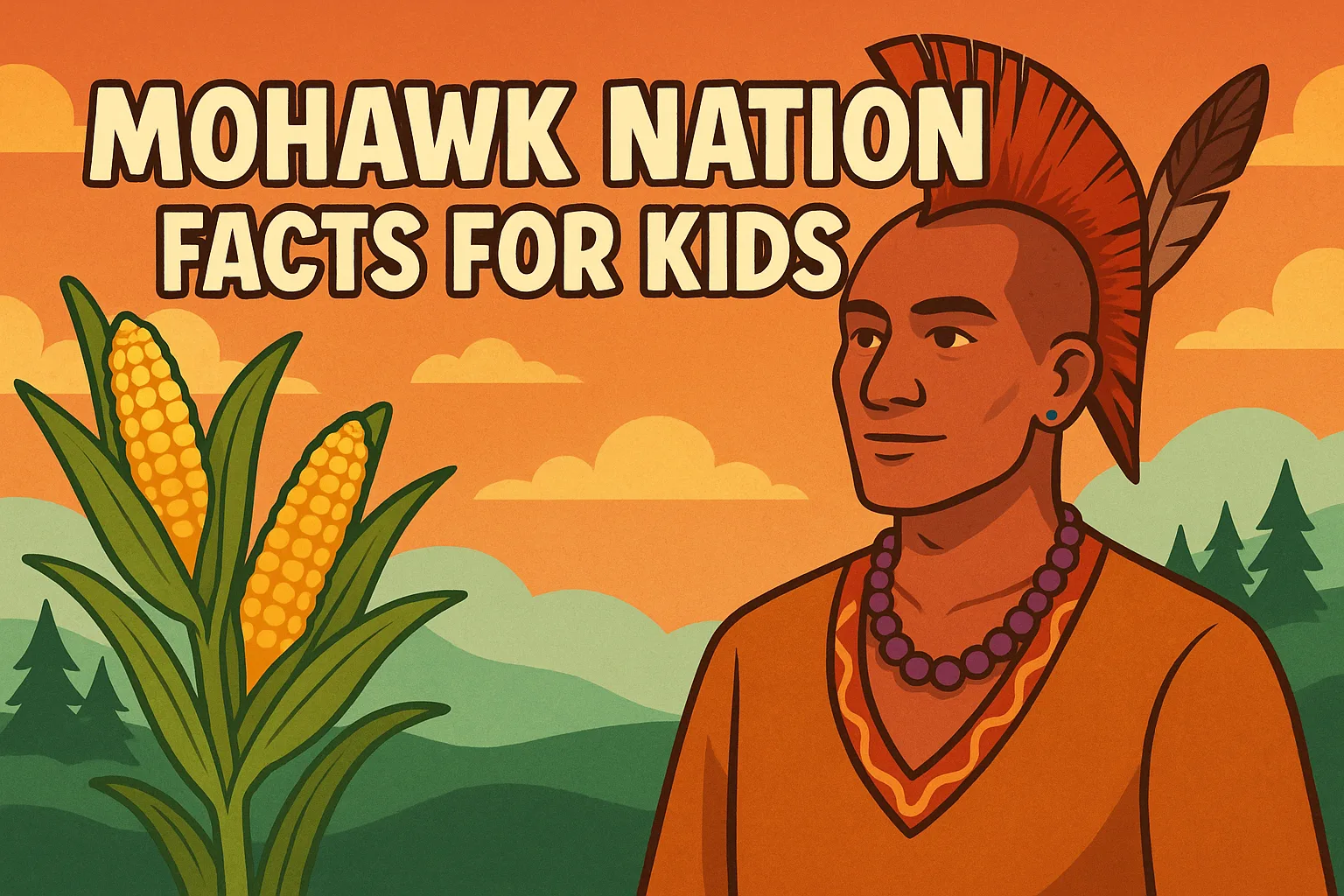As its name suggests, Tree Kangaroo is an animal that lives in trees and is closely related to kangaroos that live on land. We have listed down complete Tree Kangaroo Facts for Kids that will help you in learning all about Tree Kangaroos. You are going to learn about its scientific name & classification, evolution, appearance, physical features, physical abilities, diet, habitat, lifespan, reproduction, babies, behavior, adaptations, food chain, ecological role, endangerment, population, predators, and many other interesting facts about Tree Kangaroos.
Tree Kangaroo Facts
What is a Tree Kangaroo
- Tree kangaroos are Australia’s largest tree-dwelling mammals.
- They belong to the genus Dendrolagus.
- Tree kangaroos are the descendants of rock-wallabies and the now extinct tree kangaroo Bohra.
- 14 subspecies of tree kangaroos have been identified.
- As their name indicates, tree kangaroos spend most of their time in trees.
- They are small and their tails are about the same length as their head and body size.
- Tree kangaroos are identified by their long muscular tails, large feet, short fur, and long, pointed ears and they have a pouch on the front of the body to carry young ones.
- They are unique animals found only in Australia.
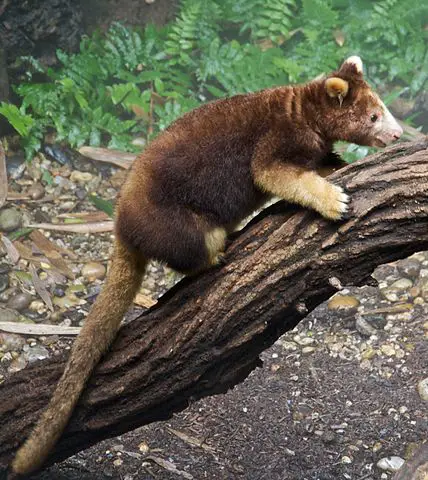
Scientific Name
- Following are the scientific names of the 14 species of tree kangaroos:
- Dendrolagus bennettianus (Bennett’s Tree Kangaroo)
- Dendrolagus dorianus (Doria’s Tree Kangaroo)
- Dendrolagus goodfellowi (Goodfellow’s Tree Kangaroo)
- Dendrolagus inustus (Grizzled Tree Kangaroo)
- Dendrolagus lumholtzi (Lumholtz’s Tree Kangaroo)
- Dendrolagus matschiei (Huon Tree Kangaroo or Matschie)
- Dendrolagus mayri (Wondiwoi Tree-kangaroo)
- Dendrolagus mbaiso (Dingiso)
- Dendrolagus notatus (Ifola tree-kangaroo)
- Dendrolagus pulcherrimus (Golden-mantled Tree Kangaroo)
- Dendrolagus scottae (Tenkile)
- Dendrolagus spadix (Lowlands Tree Kangaroo)
- Dendrolagus stellarum (Seri’s Tree Kangaroo)
- Dendrolagus ursinus (Vogelkop Tree Kangaroo)
Scientific Classification
| Kingdom | Animalia |
| Phylum | Chordata |
| Class | Mammalia |
| Infraclass | Marsupialia |
| Order | Diprotodontia |
| Family | Macropodinae |
| Genus | Dendrolagus |
| Species | Dendrolagus bennettianus Dendrolagus dorianus Dendrolagus goodfellowi Dendrolagus inustus Dendrolagus lumholtzi Dendrolagus matschiei Dendrolagus mayri Dendrolagus mbaiso Dendrolagus notatus Dendrolagus pulcherrimus Dendrolagus scottae Dendrolagus spadix Dendrolagus stellarum Dendrolagus ursinus
|
Tree Kangaroo Species
There are 14 tree kangaroo species assigned to the genus Dendrolagus:
- Grizzled tree-kangaroos (D. inustus) are found in northern and western New Guinea and the island of Yapen.
- Lumholtz’s tree-kangaroo (D. lumholtzi) is a heavy-bodied tree kangaroo found in the rainforests of Queensland, Australia.
- Bennett’s tree-kangaroo (D. bennettianus) is a large tree kangaroo found in Queensland, Australia.
- Ursine tree-kangaroo (D. ursinus) is found in the Bird’s Head Peninsula, West Papua, and New Guinea. Black tree-kangaroo, the Vogelkop tree-kangaroo, and the white-throated tree-kangaroo are other common names for this species of tree kangaroo.
- Matschie’s tree-kangaroo (D. matschiei) is an endangered species of tree kangaroos distributed across the Huon Peninsula, Papua New Guinea.
- Doria’s tree-kangaroo (D. dorianus) is one of the largest tree kangaroo species spread across western, central, and southeastern New Guinea.
- Seri’s tree-kangaroo (D. stellarum) was originally considered to be a subspecies of Dendrolagus dorianus but was elevated to species in 2005. This species is native to the highlands of west-central New Guinea.
- Goodfellow’s tree-kangaroo (D. goodfellowi) is severely endangered. There are only 48 Goodfellow’s kangaroos in zoos throughout the world.
- Golden-mantled tree kangaroos (D. pulcherrimus) are unique tree kangaroos with a double golden band on the back stretching downwards. This species is spread across the Foja Mountains, Papua, and the Torricelli Mountains, Papua New Guinea.
- Lowlands tree-kangaroo (D. spadix) is the only member of the short-footed group of tree-kangaroos distributed in the southwestern lowlands of Papua New Guinea.
- Dingiso (D. mbaiso) resembles the domestic dog in structure and habits. It is regarded as a wolf subspecies by most authorities. This species of tree kangaroos are found in the highlands of west-central New Guinea.
- Tenkile (D. scottae) is threatened by habitat loss and by hunting as it is the main source of protein for the residents of Papua New Guinea.
- Wondiwoi tree-kangaroo (D. mayri) is the rarest species of tree kangaroos and was considered to be extinct for nearly a decade until recently it was spotted again in the higher areas of the Wondiwoi Peninsula, West Papua.
Tree Kangaroo Evolution
- Tree kangaroos are the descendants of floor-dwelling pademelon-like ancestors that evolved from an arboreal possum-like ancestor in Australia and New Guinea.
- After some generations, the pademelon evolved into rock-wallabies that spread in the rainforests and adapted to tree-climbing.
- These rock-wallabies evolved into the now extinct tree kangaroo genus Bohra, which resulted in the evolution of today’s tree kangaroos.
- DNA data suggests that the tree-kangaroos separated from rock-wallabies about 5 to 7 million years ago, which is the same time they first appeared in the fossil record.
What Does a tree kangaroo Look Like
Appearance
- Tree kangaroos are often defined as being cute because of their appearance and small size.
- Unlike the ground-dwelling kangaroos, tree kangaroos have some distinct features that help them to live in trees.
- They have a thick body with shorter legs, strong forearms, and very long tails.
- For climbing and gripping, tree kangaroos have curved claws and spongy soles.
- They have small eyes and a pointy nose.
- Their ears are small and cat-like.
- Tree kangaroos have sharp teeth for shearing leaves.
- Their females have a pouch on the body for the young ones.
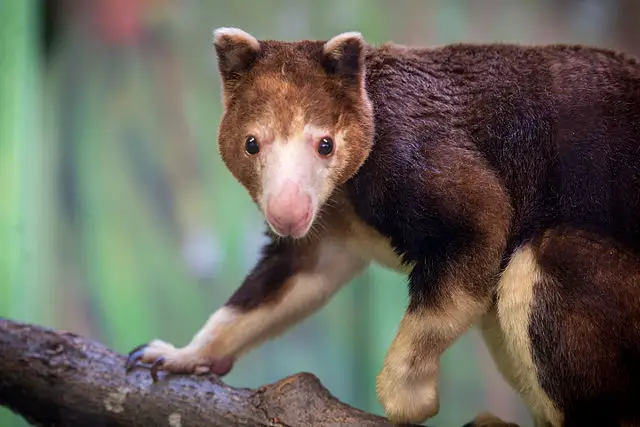
Color
- Bennett’s Tree Kangaroo species have a black chest, stomach, and tail while their back, legs, and arms are brown or grey.
- Doria’s Tree Kangaroo species is dark brown with black ears and pale brown or cream tail.
- Goodfellow’s Tree Kangaroo species has soft reddish-brown fur on the body and golden fur on its limbs, face, and underbelly. It has two golden stripes that run from its tail to its back.
- Grizzled Tree Kangaroo species have charcoal grey and chocolate brown body while their ears are black and the toes and tails are dark.
- Lumholtz’s Tree Kangaroo species have a blackish-brown fur sprinkled with a lighter shade on the lower back and a dark tail.
- Huon Tree Kangaroo species have chestnut brown fur on the body with a dark stripe down its back. Their faces are usually yellowish-white.
- Wondiwoi Tree-kangaroo species have black fur, reddish limbs, and a whitetail.
- The Dingiso Tree Kangaroo species has a distinctive pattern of black and white fur with a white belly and blackhead, back, and limbs.
- The Ifola tree-kangaroo species has dark chocolate brown fur with yellow rings around the base of the tail.
- The Golden-mantled Tree Kangaroo species is chestnut-brown with a pale belly and a double golden stripe down its back.
- The Tenkile Tree Kangaroo species has dark brown fur and yellowish-golden tail, feet, and stomach.
- Lowlands Tree Kangaroo species is reddish-brown with a paler stomach than its back.
- Seri’s Tree Kangaroo species has brown fur with silver-tipped markings on the back.
- The Vogelkop Tree Kangaroo species has long black fur on the back region while coffee-colored fur on the underside. It has a white throat and white or red cheeks.
Physical Features
| S.No | Species | Length | Weight |
| 1 | Bennett’s Tree Kangaroo | 14 kg (31 lbs) of males 10.6 kg (23 lbs) of females | |
| 2 | Doria’s Tree Kangaroo | 51–78 cm body 44–66 cm tail | 14.5 kgs (31 lbs) of males 6.5 kg (14 Ibs) of females |
| 3 | Goodfellow’s Tree Kangaroo | 77 cm body 85 cm tail | 7.5 kgs (16.5 lbs) for males 6 kgs (13 lbs) for females |
| 4 | Grizzled Tree Kangaroo | 85 cm body 74 cm tail | 15 kgs (33 lbs) for males 8 kgs (18 lbs) for females |
| 5 | Lumholtz’s Tree Kangaroo | 71 cm body 80 cm tail | 7.6 kgs for males (16.7 lbs) 6.3 kgs for females (13.8 lbs) |
| 6 | Huon Tree Kangaroo | 81 cm body 74 com tail | 7.4 kgs (15.8 lbs) of males 6.7 kgs (14.7 lbs) of females |
| 7 | Wondiwoi Tree-kangaroo | 78 cm body 66 cm tail | 9.25 kgs (20.4 lb) of males Female specimen unknown |
| 8 | Dingiso Tree Kangaroo | 67 cm body 74 cm tail | 9 kgs (20 lbs)of males 7 kgs (15.4 lbs) of females |
| 9 | Ifola Tree Kangaroo | 77 cm body 84 cm tail | 8 kgs (17.6 lbs) of males 6.3 kgs (13.8 lbs) of females |
| 10 | Golden-mantled Tree Kangaroo | 65 cm body 74 cm tail | 7 kgs (15.4 lbs) 6 kgs (13 lbs) of females |
| 11 | Tenkile Tree Kangaroo | 62 cm body 66 cm tail | 10 kgs (22 lbs) of males 8 kgs (17.6 lbs) of females |
| 12 | Lowlands Tree Kangaroo | 60 cm body 64 cm tail | 8.5 kgs (18.7 lbs) of males 7 kgs (15.4 lbs) |
| 13 | Seri’s Tree Kangaroo | 76 cm body 78 cm tail | 9 kgs (20 lbs) of males 7 kgs (15.4 lbs) of females |
| 14 | Vogelkop Tree Kangaroo | 62 cm body 92 cm body | 11 kgs (24 lbs) of males 9 kgs (20 lbs) of females |

Physical Abilities
Speed
- Tree kangaroos have a speed of 4.8 km/hr (2.9 mph).
Jump
- Tree kangaroos can jump as high as 60 feet from trees to the ground.
Climb
- Tree kangaroos are unique because of their climbing abilities. They have shorter legs and stronger limbs for this purpose.
Swim
- Tree kangaroos can swim but their swimming speed is unknown.
What Do Tree Kangaroos Eat – Tree Kangaroo Diet
In wild
- Most tree kangaroos are herbivores in nature and eat the leaves of the trees they live in.
- They have sharp teeth for tearing leaves and tree bark.
- Most of their food comes from trees but sometimes they snag food from the forest floor.
- They also eat fern, moss, nuts, and fruits.
- Flowers such as orchids are also food for tree kangaroos.
- Some species of tree kangaroos occasionally eat protein-rich food items such as eggs and birds.
- They also feed on snakes when given the opportunity.
In captivity
- In captivity, tree kangaroos are fed with lettuce, spinach, celery, carrots, corn cobs, bananas, and parsley.
- They are also given green beans and hard-boiled eggs.

List of food items
- The favourite food items of Tree kangaroos are:
- Tree leaves
- Flowers
- Grass shoots
- Ferns
- Moss
- Tree bark
What Do Baby Tree Kangaroos Eat
- Inside the womb, baby kangaroos get nourishment from the mother.
- After birth, they crawl to their mother’s pouch and stay there for about 10 months for nursing.
- The baby leaves the pouch to eat leaves and then returns after it has fed itself.
Where do Tree Kangaroos Live – Tree Kangaroo Habitat
Natural Habitat
- The natural habitat of tree kangaroo is the rainforests of Australia.
- They are adaptive to life in the trees in higher areas such as mountains and rainforests.
- They spend most of their time in tall trees to stay away from predators and feed on leaves.
- They must find comfortable and well-adaptive places for breeding, as they only give birth once a year.
Biome
- The normal biome of tree kangaroos is the lowland and mountainous rainforests of Australia.
- They also inhabit some of the islands in far northeastern Queensland.
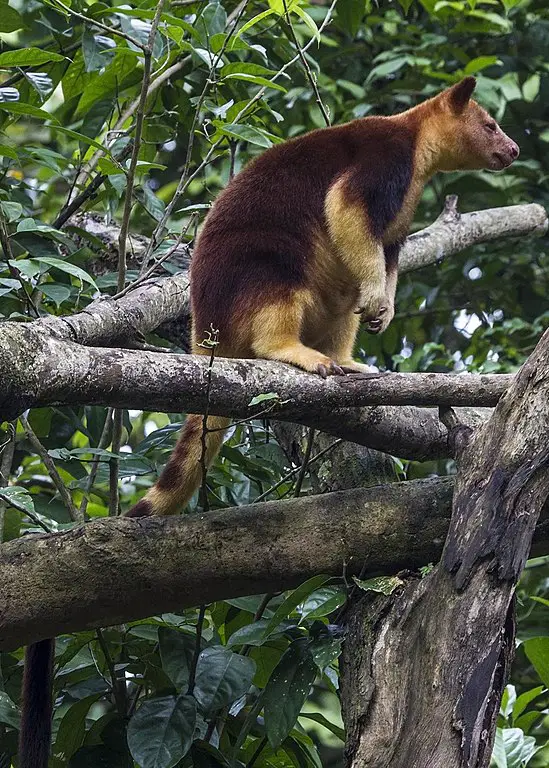
Range
- The habitat range of Bennett’s Tree-kangaroo in Australia is the Rainforest Coast area just south of Cooktown and continues down the coast to the Daintree rainforests.
- Doria’s Tree-Kangaroo species are found in the montane forests of southeastern New Guinea island.
- Goodfellow’s tree kangaroos are distributed in the mountainous rainforests in Papua New Guinea and Indonesia.
- The Grizzled Tree-Kangaroo inhabits the tropical rainforests of northern and western New Guinea.
- Lumholtz’s tree-kangaroo originally lived in the coastal lowland rainforests of New Guinea but due to the clearing of lowland habitat, it is now more common at higher altitudes above 300 m.
- Huon tree kangaroos species are native to high elevations of the Huon Peninsula.
- The habitat range of Wondiwoi Tree-Kangaroo is the Wondiwoi Peninsula of West Papua within the montane forest.
- Dingiso Tree Kangaroo species are spread in alpine forests in the Sudirman Range in Papua Province of Western New Guinea.
- The Ifola Tree-Kangaroo is endemic to the central mountains of Papua New Guinea.
- Golden-mantled Tree Kangaroo is native to the Torricelli Mountains of northwestern Papua New Guinea and the Foja Mountains of northeastern Papua Province, in Western New Guinea of Indonesia.
- The Tenkile Tree-Kangaroo species are only found in the Torricelli and Bewani Mountain Ranges of Papua New Guinea.
- Lowlands Tree-Kangaroos are native to the Southern New Guinea lowland rain forests, New Guinea island.
- Seri’s Tree-Kangaroo species are endemic to montane forests of west-central New Guinea.
- The range for Vogelkop Tree-Kangaroo is on the Vogelkop Peninsula in the far northwest of the island, New Guinea.
Countries List
- Tree Kangaroos are only found in Australia and nowhere else in the world.
Tree Kangaroo Life Cycle
- The life cycle of a tree kangaroo starts when a newborn joey crawls into the mother’s pouch for further development.
- For the first 8-10 months, baby Joey remains in the pouch to drink its mother’s milk and grow safely.
- Female tree kangaroos reach sexual maturity at about 2 years of age while male tree kangaroos attain sexual maturity at about 4 years of age.
- After reaching sexual maturity, tree kangaroos begin to search for a potential mate and start reproducing.
- Tree kangaroos are reproductive for 10-12 years.
- Their average lifespan is about 15-20 years.
Tree Kangaroo Lifespan
In Wild
- It is very difficult to study the lifespan of Tree Kangaroos in the wild.
- On average, their lifespan is somewhere between 15-20 years.
In Captivity
- Tree Kangaroos can live for more than 20 years in captivity.
- The most aged Tree Kangaroo is about 27 years old.
Tree Kangaroo Reproduction
- Tree Kangaroos give birth to their offspring, just like other mammals.
- It is not known what attracts the male and female to each other for mating as tree kangaroos live in thick forests and researchers do not know much about them.
- The gestation period is 32 days after mating has occurred.
- Tree Kangaroos breed only once a year.
- As they live high up in the trees, tree kangaroos have to find a comfortable spot for breeding such that they do not fall off the high tree branches.
- The fertile period of female tree-kangaroos is about 2 months.
- Tree kangaroos have a very unique method of reproduction in which the young (called “Joey”) is born in an underdeveloped state.
- After birth, the joey crawls to the mother’s pouch and attaches itself to a teat inside it.
- The joey stays in the pouch for about 10 months before it is mature enough to leave.
- After about 8 months, the joey initially leaves the pouch and then returns to feed.
- This in-and-out phase continues for 2 months till the joey leaves the pouch permanently.

Tree Kangaroo Male vs Female
- In appearance, male and female kangaroos can be easily identified as females have a large joey in the pouch which is easy to spot.
- Male tree kangaroos are larger and have well-developed forearm muscles.
- Male tree kangaroos often mate with multiple females.
Tree Kangaroo Behavior
- Tree kangaroos are nocturnal. They spend the daylight hours sleeping in a sitting position high in tree canopies.
- They build their nest from branches and do not mind one another even when sharing the same tree.
- Usually, male and female tree kangaroos have non-overlapping home ranges, but a male’s range will overlap several females’.
- In the wild, males display aggressiveness towards others entering their territory.
- In captivity, however, males are more tolerant of females.
- Tree kangaroos communicate with each other through chemical cues, visual displays, touch, and vocalizations.
- Tree kangaroos tend to live either alone or with very small groups, usually composed of just a female, a joey, and a male.
- The only strong bond tree kangaroos share is between the mother and her joey.
Tree Kangaroo Baby
- Tree kangaroo baby is called a joey.
- Upon birth, the joey climbs up to the mother’s pouch where it attaches itself for lactation.
- Tree kangaroo baby remains in the pouch for about 10 months.
Tree Kangaroo Adaptations
Following are some of the major physical or structural adaptations of tree kangaroos.
Dense fur
- Tree kangaroos have dense reddish-brown fur with golden stripes on their back and tail.
- As they live in trees in mountainous areas, their thick fur keeps them warm.
- The colour of their fur gives them sort of a camouflage effect as it matches the bark of trees.
Strong forelimbs
- Tree Kangaroos have adapted to life in trees. Therefore, they have strong forelimbs that help them to climb high trees.
Sharp claws
- Tree kangaroos have long and sharp claws which are slightly curved inwards. This adaptation gives them a good grip while climbing trees.
Sharp teeth
- Tree kangaroos are sharp teeth for shearing plants and leaves. They do not eat grass as they are unable to digest it.
Size
- They are typically small in size.
- Male tree kangaroos are bigger than female tree kangaroos.
Longtails
- Tree kangaroos have tails almost as big as their body and they use them to balance their body weight.
- They are very clumsy on land due to their long tail which makes it difficult for them to move properly.
- For this reason, they hop to move from one place to another.
- On the contrary, tree kangaroos are excellent at skipping trees and can jump from one tree to another that is 30 feet away within a matter of seconds!
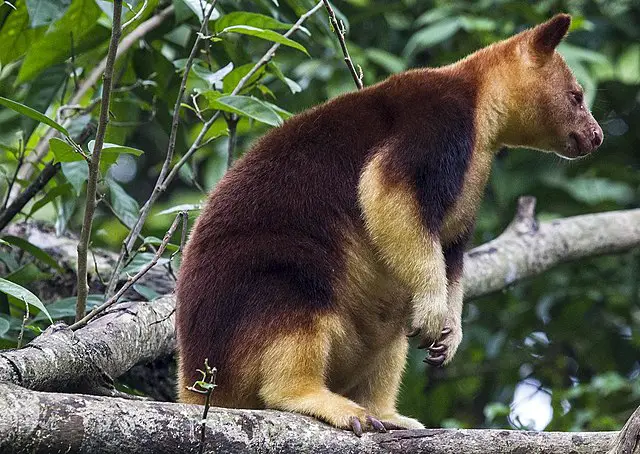
Behavioral Adaptations
- Tree kangaroos are solitary animals which means that they protect their territory and become aggressive if someone tries to enter their domain.
- Tree Kangaroos defend themselves with powerful kicks from their hind legs.
- Male tree-kangaroos will compete with others for dominance in their group.
- Female tree-kangaroos only mate with dominant males.
- Tree kangaroos are polygamous and the males have multiple female mating partners.
Tree Kangaroo Food Chain
- In the food chain, tree kangaroos play the role of consumers.
- They feed on plants, leaves, eggs, grains, and even snakes, making them both primary and secondary food consumers.
- Their predator is an amethystine python which also climbs and lives in the treetops.
- Their largest predator, however, is the human. Humans hunt tree kangaroos for their meat and thick fur.
Ecological Role of Tree Kangaroo
- Tree kangaroos play a hugely important role in the culture and diet of the indigenous people.
- They are the main source of protein for these people.
- They are hunted not only for their tasty meat but also for their rich and bushy fur.
Population
- Tree kangaroos are an endangered species.
- The estimated population of Lumholtz tree kangaroo is about 30,000 individuals.
- The population of Golden-mantled tree kangaroos is 500 individuals.
- The Wondwoi tree-kangaroo is extremely extinct with just 50 individuals.
Tree Kangaroo Endangerment
Reasons
- Tree kangaroos are only found in Australia. They act as the main source of meat for the indigenous people living near their habitat.
- Apart from being hunted for their meat, tree kangaroos are also hunted for their fur which threatens their survival.
- Habitat loss due to mining exploration also contributes to the endangerment of tree kangaroos.
- Tree-kangaroo habitats are constantly being destroyed and replaced by logging and timber production, exposing them to more predators and thus, risking their survival.
Conservation Status
- The conservation status of Tree kangaroo is ‘Critically Endangered’, according to The International Union for Conservation of Nature (IUCN).
Tree Kangaroo Predators
Following are the major tree kangaroo predators:
- The amethystine python
- Feral domestic dogs
- Local community members
Tree Kangaroo Fun Facts
- Tree kangaroos are tree-dwelling animals residing in the lowland and mountainous regions of Papua New Guinea, Australia.
- They are Australia’s largest arboreal animals.
- Tree kangaroos have tails that are almost equal in size to their bodies.
- They have a pouch on the front of their body to keep the young.
- Baby tree kangaroo is called a joey.
- Tree-kangaroos are very clumsy and lazy on the ground but are extremely agile and fast on trees.
- They are excellent leapers and can jump up to 9 meters from one tree to another.
- Tree kangaroos fight each other by boxing and are solitary animals.
- They spend most of their time in trees and lick themselves to keep cool during hot weather.
If you are also attracted by the agility and uniqueness of tree kangaroos, you may as well customize your tree kangaroo guardian pins, so that this love for the natural elves can be turned into a warm mark that you carry with you!
Custom Pins can be based on the tree kangaroo’s iconic, fluffy, long tail, round ears, and pouches, combined with tropical rainforest elements, to restore their agile posture jumping between the tree canopies, as if wearing the mystery and vitality of the Australian rainforest on their chest.
If you like tree kangaroos, then come and customize the tree kangaroo pins!





